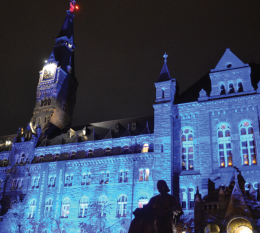
The stone facades of campus buildings were illuminated by shining blue lights as the most recent university fundraising campaign made a bold effort to be seen and heard. By all accounts, it has made its presence known.
According to Chief Operating Officer for Advancement Paul O’Neill (CAS ’86, GRD ’96), the Campaign for Georgetown: For Generations to Come has raised $848 million of its $1.5 billion goal and remains on track for completion in 2016.
“Since the successful public launch of the campaign during the last weekend in October, we continue to meet and exceed our monthly and quarterly fundraising goals and anticipate a strong first year of the campaign,” Vice President for Advancement R. Bartley Moore (SFS ’87) said.
The public launch in the fall was preceded by a beginning phase of quiet fundraising. From July 2006 to October 2011, the university brought in $778 million in the largest five-year fundraising effort in Georgetown history.
To shore up alumni support for the latter half of the campaign, the Office of Advancement has also planned a series of regional launches in major cities around the world on a smaller scale than the on-campus event in October. The first was held yesterday in Chicago to coincide with the annual John Carroll Weekend.
According to O’Neill, the funds raised from the campaign will be allocated to support the four pillars of giving upon which the initiative stands.
The first pillar, student access and excellence, has been allocated $500 million. Undergraduate programming and scholarships will receive $400 million, while graduate programming will be given theremining $100 million.
Financial aid is a priority within this allotment, according to O’Neill. The capital campaign has raised $188 million for scholarships so far and will fund about 1,000 undergraduate scholarships this year, up from 800 a year ago. Ultimately, Georgetown hopes to support 1,789 scholarships with money raised through philanthropy.
“Alumni relate very personally to the impact that scholarships have in making Georgetown accessible to the very best students, regardless of finances,” O’Neill said.
The second pillar, faculty access and excellence, will receive $500 million, $400 million of which has already been raised. Half of the money will be used to maintain existing faculty positions, create new positions and secure salary and research funding. The remaining $250 million will contribute to faculty research.
The third pillar consists of $200 million for student life and capital expansion. The proposed Intercollegiate Athletic Center and New South Student Center — as well as projects already funded and planned, such as the Calcagnini Contemplative Center in Virginia and the restoration of DahlgrenChapel — are included in this category. According to Moore, the university is planning a large-scale public push for the athletic center fundraising effort to coincide with the beginning of the 2012-2013 basketball season.
The university has raised $140 million of its $300 million goal for the fourth and final pillar, designated for “transformative opportunities,” which will develop a variety of programs that will define Georgetown in the future, spanning from the Georgetown Public Policy Institute to initiatives that promote inter-religious understanding.
To achieve long-term success in fundraising efforts, the university aims to increase the number of alumni who give back to Georgetown. According to Moore, about 27 percent of undergraduate alumni currently donate money to the university.
This number is on track to increase. According to Moore, Georgetown had more donors last year than during any year in its history and expects to break the record again this year.
If the university could up the level of alumni donations to 35 percent, it would be ranked 12th in the nation for alumni support and bolster its comparatively low endowment, which ranks 63rd in the National Association of College and University Business Officers-Commonfund Study’s rankings, and last among the top 25 American universities, according to U.S. News and World Report.
The campaign has also reeled in a number of large-scale donations from members of Georgetown’s Board of Directors. Chairman Paul Tagliabue (CAS ’62) and his wife, Chandler, allocated one-fifth of a $5 million campaign donation to expand the LGBTQ Resource Center, while campaign Chair William J. Doyle (CAS ’72) gave $10 million to permanently endow the Doyle Initiative, which he created in 2009 to increase tolerance and diversity on campus.
Additionally, the Berkley Center for Religion, Peace and World Affairs secured $5 million from its original backer, William R. Berkley, another member of the university’s Board of Directors.
In addition to soliciting donations from alumni, the Office of Advancement hopes to involve current students in every stage of the fundraising process.
“We do not want what we do in advancement to be invisible,” Moore told The Hoya at the campaign launch in October.








